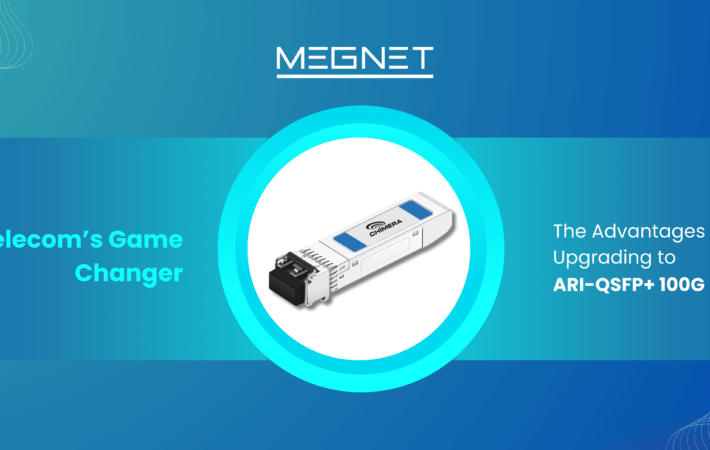
Revolutionising Telecommunications
In the ever-evolving realm of telecommunications, the pursuit of higher bandwidth, escalated data rates, and more efficient transmission stands as the driving force behind innovation. Enter the QSFP-DD Multi-Source Agreement (MSA), poised to redefine the very essence of network connectivity.
Understanding QSFP-DD MSA
The QSFP-DD (Quad Small Form Factor Pluggable Double Density) MSA represents a groundbreaking leap in high-speed data transmission. Building upon the success of its predecessor, the QSFP (Quad Small Form-factor Pluggable), this new iteration promises a substantial surge in performance and scalability.
Key Features
- Higher Density: The QSFP-DD MSA enables a doubling of port density, accommodating more interfaces within the same footprint. This advantage is crucial, especially in space-constrained data centres.
- Enhanced Bandwidth: Supporting up to 400Gb/s per port, the QSFP-DD MSA surpasses its predecessors, enabling faster and more robust data transmission.
- Backward Compatibility: Designed for interoperability, the QSFP-DD MSA ensures backward compatibility with existing QSFP modules, simplifying upgrades and transitions.
Applications
In the realm of data centres, where agility and performance are paramount, the QSFP-DD MSA presents a transformative solution. Its increased density and higher bandwidth empower data centres to meet the escalating demands of cloud computing, AI, and Big Data analytics.
- Telecommunication Networks
Telecom networks, seeking faster speeds and reliable connectivity, find significant advantage in the QSFP-DD MSA. From supporting 5G deployments to enabling ultra-high-definition video streaming, this technology paves the way for seamless communication experiences.
As the telecommunications industry progresses towards an era dominated by IoT, edge computing, and ever-expanding data volumes, the QSFP-DD MSA emerges as a crucial enabler. Its potential to drive innovation and reshape network architectures is unparalleled.
Challenges and Opportunities
While the QSFP-DD MSA brings a host of benefits, challenges such as increased power consumption and thermal management warrant attention. However, concerted efforts in research and development aim to mitigate these challenges, paving the way for a more sustainable and efficient future.
- Advanced Signal Integrity
The QSFP-DD MSA incorporates advanced signal integrity measures, enabling it to maintain robust and reliable data transmission even at higher speeds. With features like forward error correction and adaptive equalisation, it ensures minimal signal degradation and enhanced reliability, critical for maintaining data integrity across vast networks.
- Evolving Industry Standards
Embracing the QSFP-DD MSA aligns with the evolving industry standards, positioning organisations at the forefront of technological innovation. As the telecommunications landscape continues to evolve, adherence to such standards becomes pivotal for staying competitive and meeting evolving consumer expectations.
- Scalability and Future-Proofing
One of the key advantages of the QSFP-DD MSA is its inherent scalability. As technology continues to advance, the flexibility and scalability of QSFP-DD-enabled systems allow for seamless upgrades and expansions, future-proofing networks against obsolescence.
The advent of 5G technology brings unprecedented speed requirements to telecommunications. QSFP-DD MSA’s integration plays a pivotal role in supporting 5G networks by providing the necessary bandwidth and high-speed data transmission capabilities required for the seamless rollout and operation of 5G infrastructure. Telecom operators are leveraging QSFP-DD technology to handle the massive data loads expected with the widespread adoption of 5G.
- Optical Network Evolution
QSFP-DD MSA modules are at the forefront of the evolution towards higher-speed optical networks. As telecom companies seek to upgrade their network capacities to accommodate burgeoning data demands, these modules stand as a foundational element in enabling faster and more efficient optical networking solutions. Their compatibility with optical transceivers helps in driving the evolution of high-speed optical communication.
- Network Flexibility and Adaptability
In an era where flexibility and adaptability are paramount, QSFP-DD MSA modules provide telecom networks with the agility to meet evolving demands. Their ability to support diverse applications, from massive data transfers to ultra-low latency requirements for real-time applications, positions them as versatile components in modern telecom infrastructure.
- Edge Computing Enablement
The rise of edge computing, where data processing occurs closer to the source rather than in centralized data centres, demands robust connectivity solutions. QSFP-DD modules, with their high bandwidth and compact form factor, enable efficient data transmission between edge devices and centralised data centres, contributing to the seamless operation of edge computing systems.
Telecom’s Response to Increasing Bandwidth Demands
The exponential growth in data consumption, driven by streaming services, IoT devices, and remote work, places immense pressure on telecom networks. QSFP-DD MSA addresses this challenge by providing the necessary infrastructure to meet these escalating bandwidth demands, ensuring a smoother and more responsive communication experience for end-users.
Economic Advantages
Beyond technical superiority, the QSFP-DD MSA brings economic advantages. Its ability to handle higher data rates within a compact form factor reduces the cost per bit transmitted, contributing to more cost-effective network infrastructures.
Environmental Considerations
Efforts are underway to optimise the energy efficiency of QSFP-DD modules. As environmental sustainability gains prominence, the development of energy-efficient networking solutions becomes crucial. Innovations focusing on reducing power consumption in these modules are expected to align with global sustainability goals.
Collaborative Innovation
The development of the QSFP-DD MSA is a testament to collaborative innovation within the industry. The involvement of multiple stakeholders—engineers, manufacturers, standardisation bodies, and end-users—underscores the collective effort driving technological progress.
Regulatory and Compliance Aspects
Compliance with industry regulations and standards remains paramount. The QSFP-DD MSA adheres to stringent regulatory requirements, ensuring seamless integration into existing network infrastructures without compromising on compliance and security standards.
Market Growth and Adoption Trends
- Projected Growth: Industry reports forecast substantial growth for QSFP-DD-enabled devices, driven by the increasing demand for high-speed data transmission in data centres, telecommunications, and enterprise networking.
- Adoption Rates: Surveys and market analysis indicate a steady increase in the adoption of QSFP-DD modules. As more companies transition to higher bandwidth requirements, the demand for QSFP-DD compatible devices is on the rise.
Performance Metrics and Comparisons
- Throughput Performance: QSFP-DD MSA’s capability to support up to 400Gb/s per port outperforms previous iterations, signifying a significant leap in data transmission speeds.
- Density Comparisons: The QSFP-DD’s doubled port density compared to traditional QSFP modules significantly enhances the efficiency of data centre layouts, optimising space utilisation and enabling denser network configurations.
Real-World Implementations
- Data Centre Deployments: Notable data centre providers and hyperscale cloud platforms have already begun implementing QSFP-DD technology, showcasing its practical viability in high-demand environments.
- Telecom Network Upgrades: Telecom giants actively integrating QSFP-DD modules into their network infrastructures, especially in preparations for 5G expansions, underline the adaptability of QSFP-DD technology to modern bandwidth demands.
- Total Cost of Ownership (TCO): Studies suggest that while initial investments in QSFP-DD modules might be higher, the increased data throughput and density result in lower TCO in the long run.
- Return on Investment (ROI): The improved performance and scalability of QSFP-DD MSA modules contribute to a quicker ROI for organisations adopting this technology.
- Collaborative Development: The QSFP-DD MSA’s development has involved major players in networking equipment, semiconductor, and data centre industries, emphasising the collective pursuit of technological advancement.
- Standardisation Bodies: Bodies like the Ethernet Alliance and IEEE play a crucial role in setting standards for QSFP-DD MSA, ensuring interoperability, compatibility, and adherence to industry benchmarks.
Environmental Impact and Efficiency Data
Power Consumption Metrics: Efforts to optimise power consumption aim to reduce the environmental footprint of QSFP-DD modules. Studies showcase improvements in power usage per bit transmitted, aligning with sustainability objectives.
Conclusion
In conclusion, the QSFP-DD MSA stands as a testament to human ingenuity in meeting the burgeoning demands of the digital age. Its ability to deliver higher speeds, greater density, and seamless compatibility positions it as the cornerstone of modern telecommunications. As this technology continues to evolve, it promises to unlock new frontiers and revolutionise how we connect and communicate.
The QSFP-DD MSA isn’t merely a technological advancement; it represents a paradigm shift—an evolution that propels us towards a more connected, efficient and innovative future.










Leave a comment
Your email address will not be published. Required fields are marked *